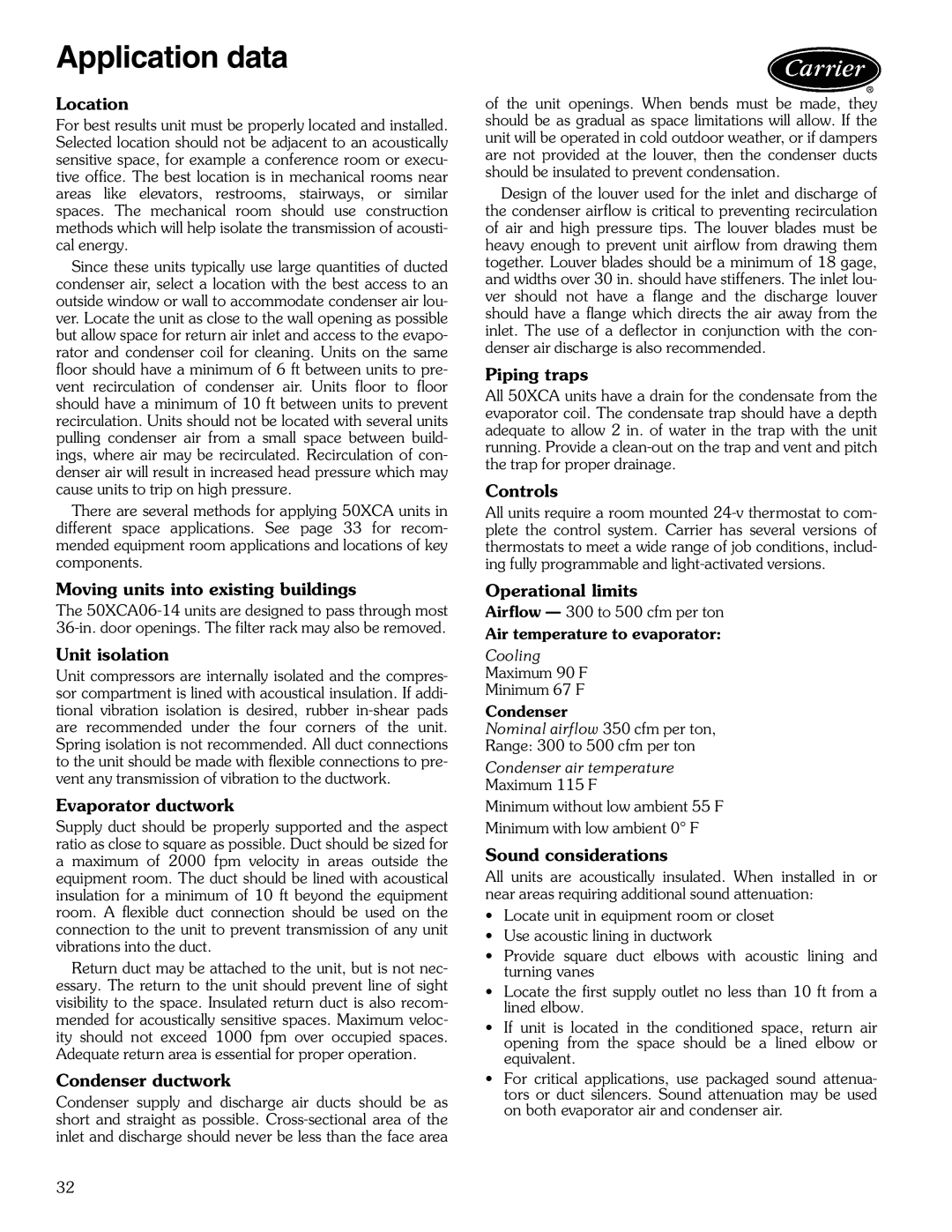Application data
Location
For best results unit must be properly located and installed. Selected location should not be adjacent to an acoustically sensitive space, for example a conference room or execu- tive office. The best location is in mechanical rooms near areas like elevators, restrooms, stairways, or similar spaces. The mechanical room should use construction methods which will help isolate the transmission of acousti- cal energy.
Since these units typically use large quantities of ducted condenser air, select a location with the best access to an outside window or wall to accommodate condenser air lou- ver. Locate the unit as close to the wall opening as possible but allow space for return air inlet and access to the evapo- rator and condenser coil for cleaning. Units on the same floor should have a minimum of 6 ft between units to pre- vent recirculation of condenser air. Units floor to floor should have a minimum of 10 ft between units to prevent recirculation. Units should not be located with several units pulling condenser air from a small space between build- ings, where air may be recirculated. Recirculation of con- denser air will result in increased head pressure which may cause units to trip on high pressure.
There are several methods for applying 50XCA units in different space applications. See page 33 for recom- mended equipment room applications and locations of key components.
Moving units into existing buildings
The
Unit isolation
Unit compressors are internally isolated and the compres- sor compartment is lined with acoustical insulation. If addi- tional vibration isolation is desired, rubber
Evaporator ductwork
Supply duct should be properly supported and the aspect ratio as close to square as possible. Duct should be sized for a maximum of 2000 fpm velocity in areas outside the equipment room. The duct should be lined with acoustical insulation for a minimum of 10 ft beyond the equipment room. A flexible duct connection should be used on the connection to the unit to prevent transmission of any unit vibrations into the duct.
Return duct may be attached to the unit, but is not nec- essary. The return to the unit should prevent line of sight visibility to the space. Insulated return duct is also recom- mended for acoustically sensitive spaces. Maximum veloc- ity should not exceed 1000 fpm over occupied spaces. Adequate return area is essential for proper operation.
Condenser ductwork
Condenser supply and discharge air ducts should be as short and straight as possible.
of the unit openings. When bends must be made, they should be as gradual as space limitations will allow. If the unit will be operated in cold outdoor weather, or if dampers are not provided at the louver, then the condenser ducts should be insulated to prevent condensation.
Design of the louver used for the inlet and discharge of the condenser airflow is critical to preventing recirculation of air and high pressure tips. The louver blades must be heavy enough to prevent unit airflow from drawing them together. Louver blades should be a minimum of 18 gage, and widths over 30 in. should have stiffeners. The inlet lou- ver should not have a flange and the discharge louver should have a flange which directs the air away from the inlet. The use of a deflector in conjunction with the con- denser air discharge is also recommended.
Piping traps
All 50XCA units have a drain for the condensate from the evaporator coil. The condensate trap should have a depth adequate to allow 2 in. of water in the trap with the unit running. Provide a
Controls
All units require a room mounted
Operational limits
Airflow — 300 to 500 cfm per ton
Air temperature to evaporator:
Cooling
Maximum 90 F
Minimum 67 F
Condenser
Nominal airflow 350 cfm per ton,
Range: 300 to 500 cfm per ton
Condenser air temperature
Maximum 115 F
Minimum without low ambient 55 F
Minimum with low ambient 0° F
Sound considerations
All units are acoustically insulated. When installed in or near areas requiring additional sound attenuation:
•Locate unit in equipment room or closet
•Use acoustic lining in ductwork
•Provide square duct elbows with acoustic lining and turning vanes
•Locate the first supply outlet no less than 10 ft from a lined elbow.
•If unit is located in the conditioned space, return air opening from the space should be a lined elbow or equivalent.
•For critical applications, use packaged sound attenua- tors or duct silencers. Sound attenuation may be used on both evaporator air and condenser air.
32
